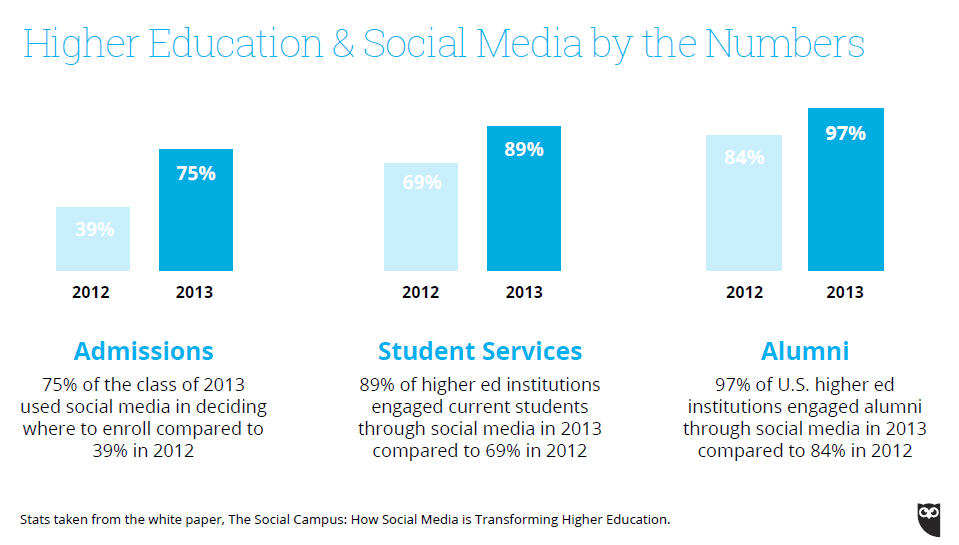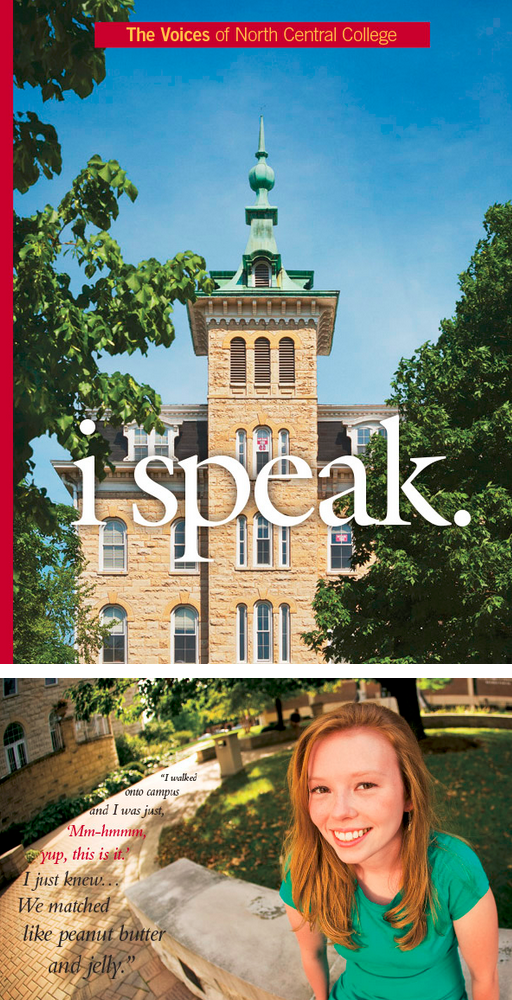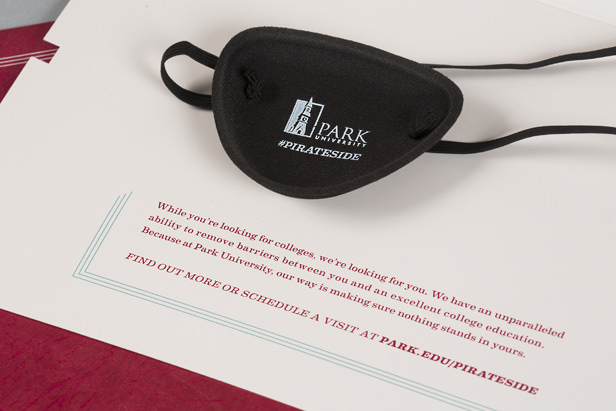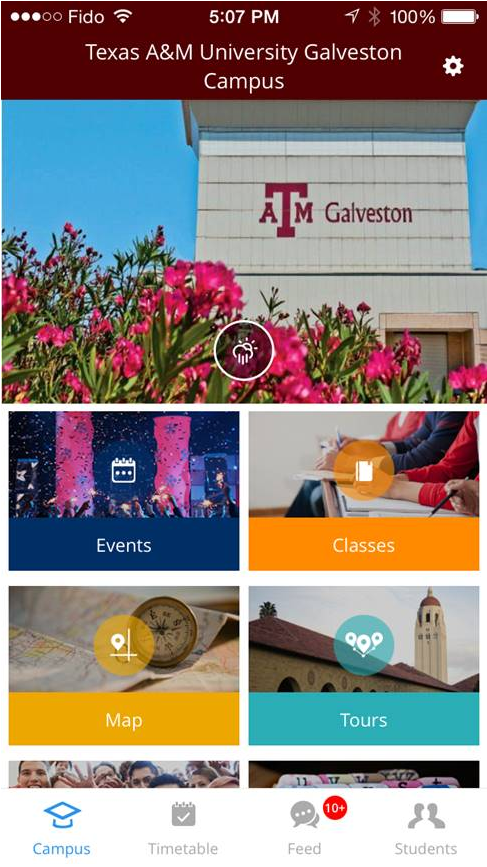Not so long ago, students who had been accepted to a college or university might expect a phone call, an invitation to an open house, and perhaps some brochures or a catalogue in the mail. What was once a reasonably relaxed time for admissions departments, post-acceptance but pre-enrollment, has become a focus of multi-channel marketing efforts that use social media and much more to sway interested but still undecided prospects.
Today’s “digital native” students research and communicate with a broader selection of schools than ever before using numerous online resources, including third-party ranking or matching websites, Common Application systems that make it easy to apply to multiple institutions at once, and various virtual tours, mobile apps and social media. According to a study of American high school students, 75% of the class used social media to decide where to enroll, and 38% said it influenced their school choice.
As students apply to more and more schools, particularly in the United States, yield rates – the percentage of admitted students that end up enrolling – have become lower and more unpredictable. Targeted initiatives aligned with students’ evolving expectations can help seal the deal for these undecided students while promoting longer-term retention and stemming “summer melt” – students paying a deposit yet not attending a chosen college when fall comes. The top reasons for summer melt are concerns about cost, social anxiety arising from moving to a strange environment, and informational barriers related to understanding various registration, housing, and orientation processes. By fully understanding and addressing the behaviour and motivations of these students, colleges can deliver the right communications at the right time to spur enrollment.
Shifting Marketing Strategy Post-Acceptance
A shift in communications strategy is necessary for accepted students who have advanced to the last stages of your recruitment funnel. These qualified prospects are so close to the desired enrollment goal that they deserve special attention to reach the final conversion. Repeatedly promoting your selling points at this stage can have the unintended effect of seeming impersonal or oppressive. This is the time to nurture the student’s relationship with the school, welcoming them to the community and stimulating excitement for the big move.
Larger applicant pools make it more challenging to build individual connections with prospects, but these strong relationships correlate to higher yields. Admissions software can help segment prospects (according to expressed interest, referral source, location, etc.) to focus messaging and yield efforts. There are many tactics for converting more student leads using multiple contact points to reach prospects and their parents with the communication methods they prefer. Multi-touch lead nurturing, such as email drip campaigns, virtual tours, and admissions advisors, and automated tracking tools, are all beneficial to recruitment. However, technology’s primary purpose should be to leverage personalized relationship-building, including the good old phone call.
Many universities pursue aggressive outreach programs to lure undecided students, including comprehensive gift packages and financial aid incentives, trying everything to make those conversions. Others have increased yield by sending select communications featuring only what people love about their school. North Central College sends their prospects a 100-page book called “i speak” full of impressions, emotions, and photographs – no institutional information, only actual voices of students, faculty, and staff.

Social Media Integration
Instead of traditional outreach methods that limit interaction, colleges seek to listen more intently to what their prospects are saying to respond with timely and tailored communications. Whereas social media was often dismissed as trivial to admissions years ago, it is now recognized as a crucial communication tool throughout the student lifecycle. It figures early and often in a student’s decision-making process. It becomes even more important as they decide whether they can see themselves fitting into a school’s community and living there for the next four years.
Social media is the virtual bridge to an active campus community in the long months before classes start. Engaging students from the beginning of their university experience sets the tone for retention, academic enthusiasm, and campus involvement. Social media is ideal for establishing this vital social engagement that creates committed students – meeting friends, quelling concerns, and learning more about campus and important events. Its immediacy encourages rapid responses and simplified sharing of supporting resources. Students are accustomed to using social media as a fluid means of self-expression, and when interacting with institutions, they want to feel it is on their terms. This means that blending social media marketing university planning needs to be kept fun and useful, calls-to-action subtle, and content relevant to the specific platform’s strengths.
Managing Social Media Strategy
Integrating social media management with a user-friendly dashboard system like Hootsuite can help schools coordinate messaging, keep track of multiple networks, and monitor activity to gauge trends or respond directly to discontent prospects. For example, Colgate University’s hashtag monitoring revealed homesickness among some student-athletes, so the dean welcomed them personally during orientation. Social media metrics such as sentiment, reach, and conversion can trace the student’s path to enrollment while demonstrating the channel’s ROI.
Understanding and internally communicating best practices for each social channel will lead to more engaging content and more efficient workflows. Facebook, for example, is the most popular channel for a variety of purposes, such as posting motivating multimedia-rich content and for influencing influencers (parents). Twitter is great for quick promotions of upcoming events or helpful information and gaining some free marketing from re-tweets. Instagram is a mobile favourite for sharing images and videos on the go. At the same time, Google+ is ideal for differentiating posts for customized circles or answering questions face-to-face in real-time via Hangouts.

Optimizing Social Media in Conversion Campaigns
Improving admissions yield with marketing initiatives begins with establishing campaign goals and an integrated strategy. A CRM or other system can be designed to track changes in student behaviour over time. Although interactions tend to occur on third-party platforms, it is possible to log and track information from Facebook. Many universities use social media “retargeting” or “remarketing” to provide gentle web-ad reminders customized to the student’s decision-making stage and program. Choosing a catchy campaign-specific hashtag encourages students to engage with the brand and with peers while making it easier for colleges to track participation. Students seek schools that enable them to unleash their originality, so campaigns may utilize contests or unusual extensions of their brand to cut through the marketing noise and generate buzz.
Example: Park University sent pirate eye patches to prospective students this year, branded with the hashtag #pirateside, encouraging them to post selfies while wearing the patch. Integrating online and offline branding via innovative marketing stunts is an increasingly popular way of gaining prospects’ interest.

Integrate social media into recruitment events by promoting “school spirit” contests and games throughout multiple channels and proactively starting conversations. The University of Arkansas created a social media scavenger hunt for their fellowship week that required students to complete a series of tasks around their campus and post on Twitter and Instagram. Email nurturing may direct prospects to segmented microsites or provide guides to living in the college’s city. Showcase current events and attractions of your region with inspiring videos, if possible, to generate excitement about the big move. Post questions creatively on Facebook that demonstrate your school’s key messaging while enabling learning about your followers, paired with exciting images or videos and links to content.

Example: Ryerson University found that students wanted social media run by their peers, so they encouraged their assembled student team to use their authentic voices on student-run accounts. Kareem Rahaman, Ryerson’s digital media specialist, advises “monitor, don’t micromanage” – thoroughly vetting and training their team resulted in more engaging messaging that remains on-brand.
RU Student Life created the Road to Ryerson blog, featuring the experiences of five first-year students, to help frosh ease the transition. Bloggers were selected from over 20 video submissions, and in the first week, they generated over 15,000 views and more than a thousand tweets using the Twitter #RoadtoRyerson hashtag. “It’s really important to share your experiences as much as you can so other people can relate to them,” said Sunita Singh Hans, one of the bloggers.

Private Social Networks
A school-sponsored private social network is an excellent way to enable authentic conversations between prospective students, providing an open space to interact and explore the school on their terms. Exclusively for accepted students, these passively-branded networks are directly connected to a student microsite and the school’s CRM to enhance the user experience and leverage gleaned information. They encourage continued engagement relevant to this stage of recruitment, helping students find roommates and answers to their concerns from student ambassadors. The conversations developed may even lead to “mutual recruitment”, where not-quite-sure students convince each other to enroll without any staff intervention.
Mobile Apps for Enrollment
The ubiquity of smartphones, particularly among teenage prospects, inspires colleges to engage with mobile apps before students step on campus. These can be integrated with social media, functioning similarly to private social networks, enabling roommate connections, other meetups, and many other tools.
Example: Last fall, Texas A&M University at Galveston implemented a mobile app fitting their branding, measurement, and reporting requirements, particularly focused on alleviating concerns of new students. It wakes students up for class, guides them to classrooms with GPS, and provides access to relevant academic events and campus community activities. Private social networks help students interact with peers and upperclassmen to ease the transition to university. Other resources include:
- Student life: campus services, events, groups and clubs
- Campus information: courses, maps, tours, links
- Student-specific information: course and personal calendar
- Communication: campus wall and groups (news, housing, ride-sharing, etc.)

Which social media tactics have improved your enrollment conversions?

FAQs
How does social media affect college admissions?
Social media was often dismissed as trivial to admissions years ago, it is now recognized as a crucial communication tool throughout the student lifecycle. It figures early and often in a student’s decision-making process. It becomes even more important as they decide whether they can see themselves fitting into a school’s community and living there for the next four years.
How does social media affect college admissions?
As student preferences evolve, colleges and universities must continue to adapt their social media mix and outreach initiatives to engage their particular communities best. Understanding your prospects will help guide efforts on which channels to focus, but an agile approach is necessary for continuous improvement.





